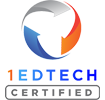Jaclyn A. Thomas, PhD
Our capacity for language is one of the few traits that seems to be quintessentially human.
Enter Online Credit Recovery Courses.
There is a surprising lack of similarity between animal and human communication. While many animals develop complex communication strategies, human language remains a novelty in the animal kingdom. This will not be a surprise if you consider all our grammar rules, strange symbols, and large vocabularies.
But all human languages follow the same general structure resulting in a communication strategy that is seemingly infinite – which is in stark contrast to the rather finite strategies employed by most communicative animals. This has led evolutionary scientists to question which forces drove the development of human language.
Some scientists believe that language evolved not by the direct forces of natural selection, but rather as a happy side-effect of the evolution of our large, complex brains. In other words, our brains got bigger and because of that, we developed the capacity for language. It is strange to think that language – an integral part of our daily lives as humans – was just a convenient by-product of a big brain.
Other social scientists believe that the evolution of language was a delicate mix of both cultural and ecological factors, and therefore, it cannot be fully understood without knowledge of the cultural history of its development.
No matter which way you look at it, one thing is clear: language is a human marvel.
The earliest evidence of a written language was found in the ancient Sumerian region (present-day Iraq) and was dated to around 3200 BCE. But the development of language actually started a bit before that.
Scientists have identified four main stages to language evolution:
- 8000-3500 BCE: Humans developed a system of tokens that represented goods, used exclusively for accounting purposes.
- 3500-3000 BCE: Humans transformed the 3-dimensional token system into one that used 2-dimensional pictographs, still used exclusively for accounting.
- 3000-1500 BCE: Humans developed phonetic signs – a turning point where a written language system began to emulate human speech.
- 1500 BCE: Humans invented the alphabet.
The alphabet is the foundation of all written languages.
And the real kicker is that we learn it as children – not only to speak our language, but to read it too.
Much like the history of language, the development of literacy in childhood can be broken into several phases:
- A) Emergent Pre-Reader (6 months-6 years): These are the formative years when children are most adaptable to learning. The brain during this period is much like a sponge, capable of absorbing sounds, words, and images.
- B) Novice Reader (6-7 years): During this period, children are beginning to learn the associations between letters and sounds – phonics! Reading aloud during this period is crucial to help children bridge the gap between our oral and written language.
- C) Decoding Reader (7-9 years): Children can understand words, but can also understand the components of words, such as their letters, meanings, and grammatical functions. They can start to read simple stories with relative ease.
- D) Fluent, Comprehending Reader (9-15 years): At this stage, children can fluently read, no matter the source. This is the turning point where reading comprehension becomes the imperative – can the child not only read the word but understand its meaning?
- E) Expert Reader (15 years & beyond): The final stage is when reading comprehension surpasses listening comprehension. Expert readers can understand complex concepts by reading about them.
In the grand scheme of human existence, reading and writing have only existed for a very short time, so the fact that we learn to read as children is a bit of a modern(ish) wonder. It took humans thousands of years just to develop the written language and now, a good portion of our early childhood education is centered on learning to read and write.
But humans are still products of our evolution, so understanding the science behind childhood brain development and literacy attainment is crucial to the success of our students.
Here at StrongMind, we have dedicated ourselves to staying on top of the most recent literature regarding the science of reading, making sure that we develop our curriculum and programs using the most innovate, evidence-based protocols for literacy attainment.






